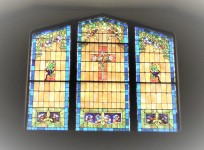
-

-
EVERYONE IS WELCOME HERE!
10:30 am Worship
-
-

-
-

-
Wednesday, July 9, 2025
Psalm 33: 3a
3 Sing for him a new song…
Joe came today to begin repairs to the pull-down attic stair which has been hanging day by day a bit lower in our garage. The drywall seams around the stair began separating some time ago, and the stair itself no longer seems safe. Its safety is no concern to me personally because I quit using it long ago, but my son-in-law, who helps us to store various seasonal decorations upstairs, uses it often. It would be disastrous if he were to fall and get hurt.
I no longer have the ability to make such repairs myself. Bad knees and hips. The distressing feebleness of old age so common in our culture. I often wonder if it’s the price of sinful living. I watched a series on television some months ago about places where many people live beyond 100 years of age. Generally, they eat more whole foods, less meat, and little unprocessed food. They are more vigorous and more active. One episode featured a Mexican cowboy who was more than 100, still working daily with livestock.
Who can really know why they live so long? It’s clear, though, we’re doing something wrong.
For quite some time, I spent quite a bit of time lamenting the loss of my ability to do many things I had always taken for granted.
No longer.
I have found a new and certain kind of freedom in my loss. I have found myself freed from my lifelong addiction to “doing.” Free to simply be.
I reread a summary this morning of the message contained in an ancient English classic on Christian mysticism, “The Cloud of Unknowing.” Many Americans, born and raised in a culture which worships achievement, find the Cloud to be so much mystic nonsense. The cloud describes “a way of life… in which one must learn to act by not acting and to know by not knowing: to have one desire alone which is not really a desire but a kind of desirelessness, an openness, a habitual freedom in the sense of self-abandonment, a realization that all God asks is ‘that you turn your attention to Him, and then let Him alone.’” (Thomas Merton, Mystics and Zen Masters, [New York: Farrar, Straus and Giroux, 1967], 138.)
Nonsense, perhaps, to those who worship “doing.” Who believe we find salvation only in completing certain tasks.
But not nonsense to me. More and more, my prayer time seems to involve simply sitting, silent, before God. Asking nothing. Seeking nothing. Just trying, as another old man once said in an apocryphal story, “to look at God while God looks at me.”
It’s a new song. Different. Wonderful. The cloud of unknowing. I don’t know what’s happening. Don’t know when it will happen. Can’t figure out where, exactly, it will happen. The only way to explain it is to say, “I don’t know.”
Thank you, God, for the new song. I know I don’t sing it alone.
Hymn of the day: The Sound of Silence. Online at Rossford UMC - Media.
Rev. Lawrence Keeler
-
-
There is currently no news.
-
Thu Jul 10 · 7:30pm Sun Jul 13 · 9:15am Adult Bible Study Sun Jul 13 · 10:30am Sun Jul 13 · 11:30am Meets in the Parlor Thu Jul 17 · 7:30pm Sun Jul 20 · 9:15am Adult Bible Study Sun Jul 20 · 10:30am View Full Calendar
Jul 2025 29 30 01 02 03 04 05 06 07 08 09 10 11 12 13 14 15 16 17 18 19 20 21 22 23 24 25 26 27 28 29 30 31 01 02 -
• The Daily Examen Prayer (Nov 29, 2022)
• A Prayer to the Divine Provide... (Nov 28, 2022)
• The Way of the Exile (Aug 24, 2022)
• Psalm 90 NIV Audio Bible (Aug 23, 2022)
• Job: Part One (Aug 22, 2022)
-

